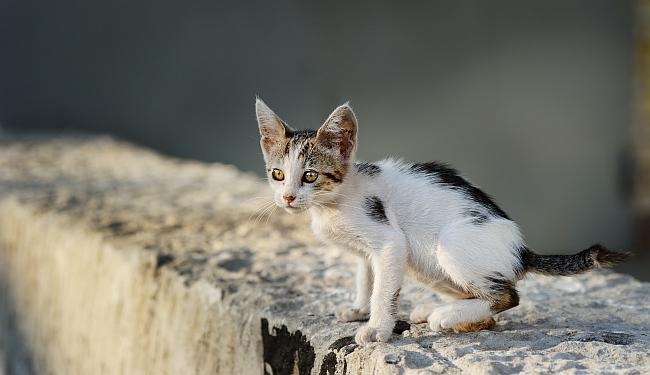
While many cats are snuggled up with their pet owners inside on dreary winter days, there are less-fortunate felines who are left to find whatever shelter and food they can outside. These cats may be skittish feral cats born in the wild and naturally wary of humans, or stray cats abandoned or lost and in need of help. Either way, even the most resourceful of survivors could use a hand in the wintertime. Here are some practical ways to help:
Helping Helpless Cats
Designate a shelter space. Create a place in your side yard or backyard where the needy cat will be able to find respite from the cold. If the area is covered by a porch roof (meaning the shelter won’t get wet, using cardboard may be a good option for a makeshift shelter. If the shelter is set up in a far corner of your yard, then consider using an empty plastic storage bin, which you can cut a hole in as a “door.” If these are unavailable, collect scrap lumber from a junk yard, or see if your local warehouse is throwing any material out. Then arrange these into a covered den, that is just roughly bigger than the animal’s body. If the space is too vast, it will not hold in the cat’s body heat, or may become a home to a larger, unwanted animal.
Set up the bedding by stuffing an old pillow case with newspaper shreds, cage wood shavings, peanut shells, or straw. This will allow them to “burrow” into the pillow and create a cozy heat-holding space to sleep in. Try to avoid stacked newspaper, blankets, rags or towels since these tend to get muddy and wet, and can even freeze if they are damp when the temperatures drop. Check on the shelter every 3-4 days to see if the pillow case needs washing and a fresh set of stuffing.
Put out food and water. Providing food and water is one of the most important ways to support these forgotten creatures. They will likely already be struggling to find consistent sources of sustenance when rodents stay deep in the ground and birds fly sparingly.
Since colder climes will be more likely to cause the canned/wet pet food to frost over, we recommend feeding the cats dry food. Note that the dish will need to be replenished every few days so that it does not become soggy with dew or rain.
Once you have established a cat shelter, set the dry food in a bowl at the far end, away from the entrance to avoid spilling. Put the water bowl in a thick plastic container or in a Styrofoam cooler bowl that is more than a few inches deep, so that it will be less likely to freeze overnight.
Ways to keep the water bowl from freezing:
- For the best results, electrically heated water bowls will keep the water at a comfortable, tepid temperature, though it will need to be regularly refilled every 24 hours. If you do not have one, insulating the shelter properly with wood shavings, newspaper and the like, should help the cat’s body heat keep both the food and water from freezing.
- To prolong the freezing process, pour hot/warm water in the bowl, unless you see the cat is nearby and may come over to drink the moment you leave. If that is the case, the water should be warm but not scalding.
- Place the water bowl/cat shelter next to warm pipes outside, or ventilators from the house that expel heated air. This is another way to keep icy waters thawed.
- If you will be away and need a longer-lasting option, you could get a rubber car tire, fill it with warm rocks and place the plastic water bowl in the middle. It is a bit of an eye-sore, but the tire will hold in enough heat from the sun and the rocks will insulate the water enough to keep it from freezing.
NOTE: Be aware that setting any food source in your yard is a risk, since felines are not the only scavengers in search of food this time of year. Food bowls could attract pests, or predators such as raccoons, bob cats and the like. Learn how you can protect your cat shelter by discouraging unwanted visitors from breaking into your yard.
Resources
http://www.humanesociety.org/issues/feral_cats/tips/caring_feral_cats_winter.html
http://www.neighborhoodcats.org/HOW_TO_PREVENTING_WATER_FROM_FREEZING

